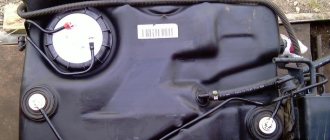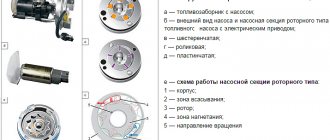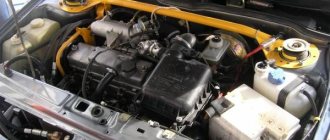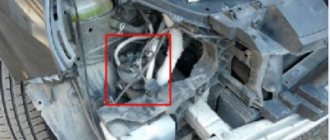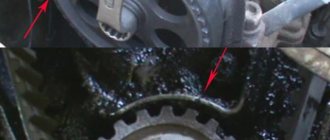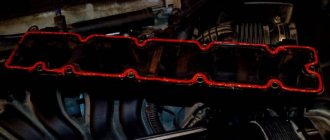Purpose of the part
Since every vehicle with an internal combustion engine is equipped with a fuel system, it also has a lid that closes or opens access to the fuel container. The small cap does the following:
- Protects fuel from theft;
- Creates additional protection against pressure drops of the combustible mixture in the tank;
- Prevents fuel leaks when the vehicle is tilted, vibrates strongly or even rolls over.
Simply put, the fuel tank cap keeps the container sealed. Thanks to it, the pressure inside the tank is within acceptable limits. Moreover, the lid is not an ordinary plug, but a structure with one or even two valves that help regulate the pressure. It is logical to assume that the roof can be easily removed for refueling.
The vapor pressure of gasoline or diesel increases sharply at high temperatures. The fact is that fuel is a mixture of volatile hydrocarbons , which means it will actively evaporate in the open air. In hot weather, fuel actively evaporates, as a result of which the pressure in the tank can reach a critical level. As a result, the fuel tank may rupture. The cap with valves can relieve pressure. But that's not all!
When the car is moving, the situation with the pressures in the tank is the opposite: due to a decrease in the fuel level, the gas pressure inside the tank also decreases. Vapors of the combustible mixture continue to form, but not fast enough - the tank gradually contracts. Auxiliary elements of the lid can compensate for this lack of pressure. As you can see, although the part seems simple and uncomplicated, it actually performs several functions. And everything was successful, as we will now see.
Quirks of the fuel tank. What kind of meanness is a fuel storage tank capable of?
The fuel tank is far from the most troublesome part of the car. And what kind of surprises, it seems, can be expected from a container intended only for storing the reserve of fuel carried in a car?
However, as you know, the only thing that doesn’t cause trouble is what is not in the car, and since a fuel tank is a mandatory attribute of any vehicle equipped with an internal combustion engine, only an incorrigible optimist can hope that the tank will never make its existence known.
Having rummaged through your memory, some of the owners of diesel cars will probably remember how, in the cold winter, the engine refused to work due to the clogging of the power system with paraffin mucus.
One of the bottlenecks in the power system is located in the fuel tank. The paraffin that falls out of the fuel at low temperatures clogs the fuel intake strainer, and to clean it you will have to visit the tank.
Among motorists, it doesn’t matter whether they drive diesel or gasoline cars, there are those who have not forgotten how in the winter they took handfuls of ice out of the tank, which again clogged the fuel intake and made it impossible to start the engine, and at the same time wondered where it came from in the tank. so much water.
However, in the case under consideration, the owner of the car figured out with his own mind who was to blame for what happened, because he was faced with a repetition of the situation with the water “extravaganza.”
For the first time, moisture in an amount that could not be attributed to the condensation of water vapor entering with the air ended up in the tank due to the fact that the seal of the fuel intake cover became leaky.
And repeating what had been done taught the owner that not every material at hand is suitable for making a new gasket on his own. If it is rubber, then it must be gasoline and oil resistant, otherwise the gasket will not last long.
Of course, there are other reasons why water may end up in the tank. Some owners who have used the services of people offering to buy fuel in a canister at a low price have learned from their own experience that in addition to fuel, the same canister can also contain water.
A steel tank can rust. At the same time, depending on where the corrosion has dealt with the tank, it flows or becomes accessible for dirt to get inside. And no one knows which is worse.
Since the tank rusts not only from the outside, but also from the inside due to the condensation of moisture from the atmospheric air entering the tank, the fuel intake already mentioned twice above can become clogged with corrosion products. In addition to them, sludge may become attached to the intake grid, which appears due to the oxidation of the fuel in the tank. The consequences are the same as in the case of paraffin deposits on the mesh, except that removing this dirt is not as easy as paraffin.
And how can we not remember the fuel tank ventilation system? In addition to the fact that due to ventilation, moist atmospheric air enters the tank, this system, or rather, its EVAP (Evaporative Emission) subsystem, depending on the car model, can have several dozen fault codes assigned to the on-board diagnostic system.
Therefore, when the owner of a car turns to a service station to find out the reason for the Check Engine light on the dashboard not only before starting the engine, but also while driving, and the diagnosticians answer him that the problem was caused by an improperly closed tank cap, this is not a joke, although there is some joke in There is, of course, such an answer.
The tank must be ventilated to maintain a pressure close to atmospheric pressure. The consumption of fuel from the tank to power the engine contributes to the appearance of a vacuum in the tank. The return of unused fuel to the tank, as well as hot weather, causes heating and an increase in pressure in the tank. In any of these cases, if there is no ventilation, the tank may become deformed.
Everything would be fine with ventilation, but hydrocarbon vapors are released from the fuel. First of all, this disadvantage is typical for easily evaporating gasoline. Hydrocarbons are toxic, which is why modern cars, as required by law, use a closed-type gas tank ventilation system.
In such a system, the ventilation tube of the tank is not vented into the atmosphere, but into the adsorber. Activated carbon located inside the adsorber traps fuel vapors and releases clean air into the atmosphere.
But the storage capacity of coal is by no means unlimited. To renew them, regeneration is required, which is carried out by purging through pipelines connecting the adsorber on one side to the atmosphere, and on the other to the engine intake manifold.
Since the fuel-air flow of canister regeneration enriches the fuel mixture entering the engine cylinders, this flow must be regulated to obtain a stoichiometric fuel-to-air ratio. For this purpose, the solenoid valve for purge the adsorber is designed, which opens and closes fully or partially according to commands from the electronic engine control unit.
In addition, the ventilation system must include shut-off and safety valves and a pressure sensor. This is the general EVAP diagram, but it also gives an idea of why the on-board diagnostic system will respond to incorrect operation of the tank ventilation by at least lighting up the Check engine, and then, depending on the year of manufacture of the car, by switching the engine to emergency mode and even refusing to start. The stricter the environmental regulations corresponding to the year of manufacture of the car, the more serious the consequences of EVAP malfunctions can be.
Car owners who have punctured the tanks can add their share of “pepper” to the poignancy of the plot about the on-board tank for storing fuel reserves. In some cars, the tanks became victims of driving on bad roads or off-road.
But it also happened that a hole in the tank was made by a foreign object lying on the road and lifted by a run-over wheel.
If the tank cap is equipped with a lock, history knows of cases when this lock, although it is located under the hatch, was caught by frost in the same way as door locks. And since this became clear just at the moment when the car was approaching the gas pump with the last drops in the tank, not all owners had the patience to realize that it was better to drive somewhere to the side and deal with the traffic jam in a calm environment. As a result, many locks were simply broken or, if you like, hacked by the owners themselves.
And, by the way, for the same reason, some owners broke tank hatches if they had their own lock.
And these are not all the problems that are somehow related to the fuel tank. The fuel level sensor in the tank or the fuel pump, if it is located in the tank, may remind you of itself.
There is always a chance, when opening the tank cap, to hear a sound like a “clunk”, which will tell you that not everything is fine with the cap and ventilation. In general, the list of “surprises” that can be expected from the tank is large enough so that during the period of operation the car owner does not have a reason to say an unkind word about the fuel tank at least once. We can only hope that the ABW.BY forum participants, when discussing the article, will add something from their personal experience to what is said in it.
Sergey BOYARSKIKH Photos by the author and from open sources ABW.BY
Large selection of fuel tanks for any car on the BAMPER.BY . Look for spare parts correctly!
Fuel tank cap device
The basis of the lid is a body with threads or several protrusions at the bottom. There are also 1-2 valves . The upper part of the housing has a protective casing with holes made through which air can move. These holes may also be located in the side of the housing where it meets the casing.
As for valves, their design may include:
- Plug or diaphragm;
- Pin.
Diaphragm intake valves are the most advanced. They can relieve excess pressure in the tank in less than a second. Their throughput is also very high. The plug or diaphragm is pressed against the inlet by a small spring and is most often removed from the cap as a separate structure hidden inside the cap. Pin valves are a simple design, one part rests against the bottom of the lid, and the other completely closes the hole in the plug. There are discs on both sides of the pin.
In the case where the lid has two valves, they are combined into a so-called air-steam path. In fact, both valves operate independently independently, although it appears that they are a single design. Car designers usually use a pin valve as an intake valve. It is mounted directly on the large diameter diaphragm associated with the exhaust valve. It is possible to use two diaphragm valves, with the inlet diaphragm located on the outlet. The orientation of the valves is not horizontal, but vertical .
In motorcycles, buggies and other vehicles that are highly susceptible to rollovers and rolls while driving, fuel tank caps are even simpler. To prevent pressure leaks, the designers did the following: They took a metal cone called a seat, adjusted the shape of the cone, and placed a ball in it. When the vehicle rolls over, the ball rolls up and closes the valve opening by rolling down the seat. In the normal position, the ball returns to its place without interfering with the gases passing through the valve.
Can the gas cap affect the pressure in the fuel system?
- Registration
- Entrance
- To the beginning of the forum
- Forum Rules
- Old design
- FAQ
- Search
- Users
The story is long-standing - it lasted 2 years. When driving, pressure then formed in the tank, and then a vacuum. The reason is the lack of ventilation of the tank; the ventilation system, which is located in the rear arch of the car, is clogged. I didn't want to get there at all. As a result, the tank began to play, it was either pulled in or pushed out, which was clearly visible from the fold that formed on the bottom of the tank. The apocalypse came over the weekend. I left the store, looked at the car from behind and saw a puddle under the car, and dripping from under the bottom. Approaching the car, I immediately realized that there was gasoline and the smell was excellent. As a result of playing with the bottom of the tank, the tank cracked, fortunately only a small one. But enough for the gasoline to spread across the entire bottom of the tank and drip onto the ground. I rode the rope home; I didn’t want to start it up and repeat Gastello’s feat.
